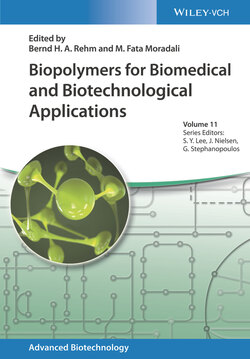Читать книгу Biopolymers for Biomedical and Biotechnological Applications - Группа авторов - Страница 13
1.3.1 Chemistry of Biopolymers and Risk
ОглавлениеBased on their physicochemical properties, various biopolymers so far used in the medical industry can loosely be placed into three categories: polysaccharides, proteins, and polyesters. Some examples of common biopolymers are shown in Table 1.2.
Table 1.2 Examples of common biopolymers.
| Classification | Example biopolymer | Notes on production | Risks |
|---|---|---|---|
| Polysaccharides | Hyaluronic acid, HA (polymer of D‐glucuronic acid and N‐acetylglucosamine) | Primarily produced using bacteria including Streptococcus | Production by pathogenic bacteria coproduces myriad other potentially toxic biological products that must be removed during subsequent purification steps |
| Cellulose (polymer of D‐glucose) | From plant products, cellulose is dissolved from other plant materials in an alkali process, followed by purification. Produced bacterially using Acetobacter xylinum [8, 9] | Industrial purification steps can introduce impurities. Bacterial production coproduces myriad other potentially toxic biological products that must be removed during subsequent purification steps | |
| Proteins | Silk Primarily fibroin, a repeating amino acid sequence of (Gly‐Ser‐Gly‐Ala‐Gly‐Ala) | Primarily from the mulberry silkworm Bombyx mori [10] | Industrial post‐processing and purification steps can introduce impurities |
| Polyesters | Polylactic acid | Primarily ring‐opening polymerization of lactide (cyclic lactic acid dimer) [11] | Crude lactic acid contains many impurities (acids, alcohols, metals) |
While the chemistry of biopolymers and the source of these materials' building blocks are very diverse, there is a commonality among them when it comes to potential patient risk: there is always concern over side products and manufacturing residuals. While it is accepted that biopolymers have an inherent advantage from being similar chemically to substances naturally found in the body, they also have the same disadvantage facing all medical device materials from being processed. For that reason, the chemical evaluation strategy used for medical devices made from biopolymers is very similar to what is used for devices made from fully synthetic materials. The heart of the strategy is acknowledging that the manufacturer of the device does not know what they do not know, and the only way to safeguard against unpleasant surprises is to screen for everything that might reasonably be in or on the device.
